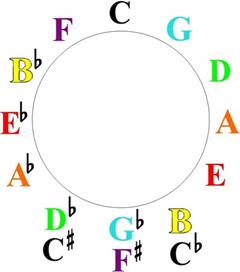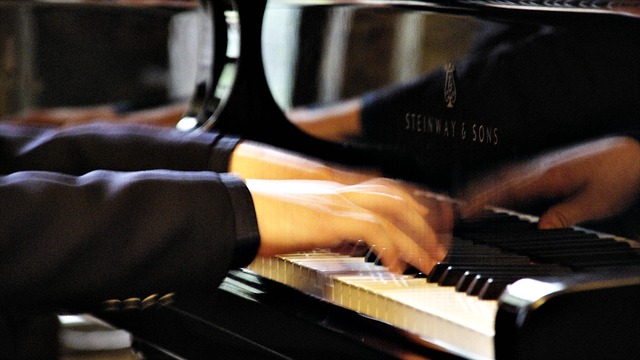When you think of a chord progression, it usually involves a sequence of just more than two chords. What I’m going to share with you today is the concept of using just two chords in a very simple progression. What I’m referring to is the Major 7 / 11th chord sequence with some voicing options to add variety.
We’re starting out our Major 7 / 11th chord sequence by playing a Major 7 chord. We’re then moving to the 11th chord based on the root note of the chord we just played. (It really helps to know your Major Chords so learn them)
A simple C Major triad…
Now, let’s add the Major 7th tone to this C Major Triad. The Major 7th tone is found by counting to seven up the key from the root.
Add the 7th to the C Major Triad and you have the C Major 7th Chord.
Now let’s double the root by playing it in the bass. The left hand plays the root in octaves and the right hand plays the rest of the chord (as shown in this Keyshot)

We’re going to keep the root in our left hand and add G which is the 5th of C. In our right hand, we’re going to find the note that is a whole step below the root of the C chord, (which is B flat). Based on that note, we’ll play a B flat Major triad in root position. This results in a C 11 chord.

Even though we only have two chords in this sequence, it gives us the basis of creating a continuous progression out of them.
There’s a myriad of options as to where you can go with this Major 7 / 11th chord sequence but, let’s take what is one of the most natural approaches to chord  progressions. I’m actually referring to circular movement.
progressions. I’m actually referring to circular movement.
I won’t get into deep details about circular movement here, but in a nutshell, it’s simply moving through the circle of fifths. Most piano students are taught that the circle of fifths is just an old time info graphic for key signatures. But there are so many other things that this tool will help you do.
The one I’m going to share with you is circular chord movement. What it’s essentially going to do is take this progression through all 12 Major keys. We’ve actually started this progression off in the key of C major. If you’re familiar with the circle of fifths, then you know that C is at the top of the circle.
You should also notice that this Major 7 / 11th chord sequence is in the same key (C) but has different qualities. One is Major and the other is suspended. When played consecutively, they have an interesting contrast. (play them on your piano or Keyboard)
Where can we go after C? Let’s try moving counter- clockwise through the circle. This obviously means that were now moving to F.
Here’s our F Major triad.
So our next chord is going to be F Major 7th. The same concept that applied to finding the Major 7th in C Major applies to F Major. But, why don’t we use another simple strategy to locate the Major 7th tone in the key of F?
To find the Major 7th tone, just locate the note that is one half step below the root.
In this case, the tone that is a half step below F is E. So the Major 7th of F is E. Let’s move it up an octave for a more definitive voicing of the F Major 7th chord.
We’ll double the root in the left hand as we did in C.
We’re going to keep the root in our left hand and add C which is the 5th of F (just as we did in the C chord). In our right hand, we’re going to find the note that is a whole step below the root of the F chord, (which is E flat). Based on that note, we’ll play an E flat Major triad in root position. This results in an F11 chord.
Are you starting to see a pattern with this two chord sequence? Here’s a recap of the Major 7 / 11th chord sequence formula:
- Choose the chord (C, F, G etc.)
- Play it with a Major 7 chord quality and voicing as shown earlier
- Change the voicing in your right hand by playing a Major triad based on the note that is a whole step below the root (this creates an 11th chord)
Look at the circle of fifths. Can you determine what chord comes next? Remember, we’re moving counter clockwise so it’s easy to see that our next chord is B flat. Cycle through the circle of fifths with this progression. It’s fun and more importantly, it’s an exercise that sounds very musical.
After getting your hands on these two chord progressions, it’s easy to hear that you could interject the Major 7 / 11th chord sequence into a real song or piece of music. But what else can you do to add some variety, instead of playing these two chords in the same voicings in all keys?
Well…change up the voicings. If you haven’t noticed, the voicings I started out with don’t actually move very smoothly from one chord to the next. In other words, the “voice leading” isn’t great. But, it’s easier to demonstrate two hand chord voicings when you can get them to look like two very simple chords in two hands. So that’s the reason I chose the initial chord voicings for the Major 7 / 11th chord sequence .
Let’s look at what we can do when we alter the chord voicings for smoother voice leading. As you can see, the C Major chord that we started out with has a slightly different voicing. Even though the notes have been rearranged, it’s the same chord. The beauty of alternate voicings is that they give chords a variety of different sounds with the same notes.
CM7 with a different voicing…
…and the C11 chord with a different voicing. Notice that the B flat is also being doubled by the left hand this time.
Let’s change the voicing to the next chord in our sequence. F Major 7 is a little more open sounding with this voicing.
…and the 11th chord has a similar voicing but the spread between both hands is wider.
Now, let’s continue and augment these voicings by doubling up on some tones in the right hand.

As you can see, for every tone that you have in your right hand, there’s a different inversion you can play.


You can play these chords in different registers of the keyboard. You can arpeggiate them. You can play them with rhythmic patterns. There are a lot of options.
- move up in 5ths instead of 4ths …..(done)
- move step wise instead of circular
- primary chord movement (1 4 5, 1 5 4, etc.
- Interjected into a progression: ex (2 5 1)…..done
Now let’s look at this progression in 5ths instead of 4ths. This means that instead of going around the circle counter clockwise, we’re going to be moving clockwise. So we’ll start with C. I’ll even continue to change up the voicings.

…then a fifth up from C will be G.

Up a fifth from G is D. So moving on around the circle…

I think you get the idea. We’ve moved circularly in 4ths and 5ths. But how else could we move with this progression? It’s obvious that we could move in this sequence through one of many chord progressions that we may hear within a song.
Let’s take a 2-5-1 progression in the key of C Major and interject this 2 chord sequence within it. It may look like this if you’re using the common voicings:
…the ii chord…
…the V chord…
…the I Chord
Now, let’s create a variation of the 2-5-1 chord just by changing the voicing in our 2 chord…
…and essentially playing it twice with the featured concept of this article.
…the ii chord.

Just for variety, I chose an 11th chord quality for the 5 chord because it essentially has a stronger pull to the 1 chord than a 5-7 chord does.
I chord…the same voicing as before.
You can also interject this concept in a chord progression moving stepwise. Let’s try a 1-3-4-5 chord progression in F Major.
The I chord…
…proceeds to the iii chord which we’re using a Major 7th chord quality.
…the iii chord is then re-voiced to be a Major 11 chord.
…proceeding to the IV chord. …and then the V chord.
…and then the V chord.
Remember that you have all 12 Major keys of music to use this two chord sequence within. Play around and experiment.
Until next time, Go Play!
Greg Lee
Latest posts by Greg Lee (see all)
- What is a minor/Major 7 Chord? - October 26, 2023
- 7 Chord Substitutions that Professionals Use - October 19, 2023
- 5 Simple Chord Tricks to Sound Amazing - October 5, 2023





